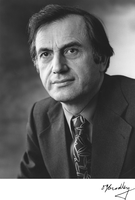Daniel Joseph Bradley facts for kids
Quick facts for kids
Dan Bradley
FRS FInstP MRIA
|
|
|---|---|
 |
|
| Born |
Daniel Joseph Bradley
18 January 1928 |
| Died | 7 February 2010 (aged 82) |
| Alma mater | Royal Holloway, University of London |
| Children | Donal Bradley |
| Awards | Cunningham Medal Royal Medal Young Medal and Prize |
| Scientific career | |
| Institutions | Trinity College, Dublin Imperial College London Queen's University, Belfast |
| Thesis | A high resolution interference spectroscope (1961) |
| Doctoral advisor | Samuel Tolansky |
| Doctoral students | Martin Richardson J. Roy Taylor |
Daniel Joseph Bradley (1928 – 2010) was an important Irish physicist. He was a professor who studied how light works, especially with lasers. His work helped us understand and use lasers in new ways.
Contents
Early Life and Learning
Daniel Bradley was born in Derry, Northern Ireland, on January 18, 1928. He was one of four children. He left school early to work as a telegraph boy. But he soon went back to school at St Columb's College.
He then trained to be a teacher at St Mary's College in Belfast. He finished his training in 1947. While teaching in Derry, he studied math on his own. He earned a degree in mathematics from the University of London in 1953.
Later, he moved to London and taught math at a high school. He decided to study more in the evenings. He wanted to study math again, but was told to try physics. They said physics was "a bit like mathematics."
In 1957, after four years of part-time study, he earned a science degree in physics. He got the highest marks in his final exams across the whole University of London. He then joined Royal Holloway College as a helper. He also started his PhD, studying how to use light to see very small details. He earned his PhD in 1961.
Amazing Work with Lasers
Daniel Bradley was a leader in the field of laser physics. He worked on making super-fast laser pulses. These pulses are incredibly short bursts of light. Imagine a picosecond: it's like comparing one second to 31,800 years! His work opened up a whole new area of science. This new area is called non-linear optical interactions.
He also inspired many new laser scientists. Many of his students became world leaders in their fields.
Research at Imperial College
He became a lecturer at Imperial College London. There, he started a project to study the sun's light. He used rockets to send equipment high into space. This helped him study ultraviolet light from the sun.
In 1963, he began working with lasers. A year later, he returned to Royal Holloway College. In 1966, he became a professor at Queen's University, Belfast.
Leading Laser Research
At Queen's University, he quickly built a top-notch space research team. They continued to study the sun's light in great detail. He got a lot of money for his research. This helped him build his department into one of the best laser research centers in the world. About 65 scientists worked there.
However, he left Belfast in the early 1970s. This was because of political problems in Northern Ireland, known as The Troubles. He was worried about his family's safety.
In 1973, he went back to Imperial College London. He became a professor of laser physics. He led a group that studied light, lasers, and space optics. He was also the head of the Physics department from 1976 to 1980.
One of his biggest contributions was helping to set up the Central Laser Facility. This is a world-leading laser research center. It is located at the Rutherford Appleton Laboratory (RAL) in the UK.
New Directions in Dublin
In 1980, he moved to Trinity College, Dublin. He decided to try something new. He wanted to use lasers for practical things, not just to develop them. In 1982, he teamed up with a chemist and a geneticist. They won money for a project. They used laser methods to study the structure of important molecules. These included DNA and proteins.
Sadly, his work at Trinity College was cut short because he became ill. He retired in 1984. But his research on special lasers called semiconductor lasers continued. Other scientists carried on his work. This work helps develop lasers that can be tuned for optical communication systems.
During his career, he guided over 60 students who were getting their PhDs. Many of his students said he was an "inspiration" and a "great role-model."
Awards and Special Honors
Daniel Bradley received many awards for his important work. He was a member of the Royal Irish Academy. He was also a Fellow of Trinity College Dublin, the Royal Society, the Optical Society of America, and the Institute of Physics.
Some of his awards include:
- The Young Medal and Prize from the Institute of Physics (1975)
- The Royal Medal from the Royal Society (1982)
- The Charles Hard Townes Medal from the Optical Society of America (1989)
- The Cunningham Medal from the Royal Irish Academy (2001)
- Honorary degrees from the University of Ulster (1983) and Queen's University Belfast (1986)
Personal Life
Daniel Bradley was married to Winefride O'Connor. They had five children: Mairead, Sean, Donal Bradley, Martin, and Ronan.

